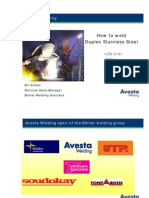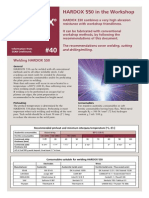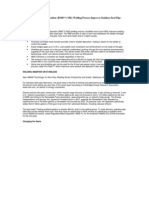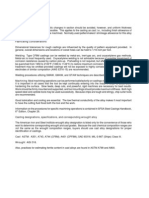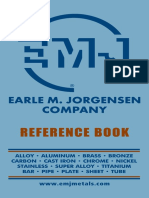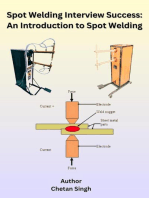SS 409M Welding
SS 409M Welding
Uploaded by
wentropremCopyright:
Available Formats
SS 409M Welding
SS 409M Welding
Uploaded by
wentropremOriginal Description:
Copyright
Available Formats
Share this document
Did you find this document useful?
Is this content inappropriate?
Copyright:
Available Formats
SS 409M Welding
SS 409M Welding
Uploaded by
wentropremCopyright:
Available Formats
Practical Guidelines for
Fabrication of SS409M
By K R Ananathanarayanan
www.stainlessindia.org
The Material presented in this
publication has been prepared
for the general information of the
reader and should not be used or
relied on for specific applications
without first securing competent
advice.
Indian Stainless Steel Development Association
K-36 (FF), Hauz Khas Enclave, New Delhi - 110 016
Mobile : 9810404044, 9910007552
E-mail : nissda@gmail.com
Web : www.stainlessindia.org
Guidelines for the Fabrication of SS409M
(INDIAN RAILWAY SPECIFICATION IRSM44 IS SIMILAR TO SS409M
in respect of Fabrication Characteristics)
CUTTING
Maintain Rake
Clearance Angle
as large as
possible
Cutting of 409M using the oxyacetylene or oxyhydrogen processes is not practical:
Cutting is subdivided into:
Guillotining
Hold-down
Bar
The guillotine is normally used for cutting steel up to
16mm thick. The maximum capacity of the guillotine
(for mild steel shearing) should be downgraded by 3040% for cutting 409M because of 409M's greater
shear strength, e.g., if maximum shearing capacity is
16mm (mild steel) then the maximum shearing
capacity will be 11mm for 409M. Shear breaks on
the cut edge can be prevented by using well
sharpened, correctly aligned and set
blades,
especially for plate heavier than 8mm.
Moving Blade
15 Degree
The most suitable shear blades for cutting 409M and
stainless steel are made of high carbon high
chromium tool steel. The blades must be kept sharp
a good test is to cut a piece of paper.
rollover
Good practice is to wipe the blade and hold down pads
free of adherent mild steel particles prior to cutting
409M. This will avoid mild steel contamination.
burnish
penetration
plate thickness
Where possible, shearing speeds should be reduced
by up to 20%. This will prevent shear break of thick
plates.
shear break
fracture
Plasma cutting
Due to the high chromium content of 409M, it cannot
be cut with the conventional oxy-acetylene torch.
Plasma cutting and profiling of 409M is the fastest and
most economic thermal cutting speeds together with a
clean smooth surface finish can be achieved. Due to
the fast cutting speeds, the heat affected zone is very
narrow, minimizing the effect on the properties of the
material. Thin plates can be stackcut.
Any
discoloration of the cut edge can easily be removed by
grinding or by using a stainless steel wire brush. If no
subsequent welding is undertaken, edge
discoloration must be removed, followed by
passivation.
burr
Goometric leatures of sheared edge.
Burnish and burr heights increase with increasing
blade blundness and blade gap. Rollover tends to be
excessive.
Shear break or splitting should not be confused with
laminations as the former is a result of the shearing
process parameters, while the latter is a material
defect. Shear break is caused by excessive cutting
speeds, blade clearance etc.
The following guillotine clearance settings are recommended.
Plate Thickness (mm)
Clearance Settings (mm)
10
12
16
20
22
25
0.1
0.15
0.25
0.3
0.4
0.45
0.5
0.6
-1-
Cutting Gases
Abrasive Cut-off Wheels
Today, there are many makes of portable plasma
cutting machines which are able to cut up to 25mm
thick plate. These portable units make use of
compressed air, (300-500 KPa) rather than mixed
plasma gases. These machines are light, (weighing
not more than an oxy-acetylene set) economical and
efficient. Consumable item is the torch tip.
Abrasive disc cutting is acceptable for limited lengths
of cut. Only dedicated discs should be used and
suitable control of the storage of these must be
exercised. Excessive overheating must be avoided.
Use can be made of water soluble oil for cooling /
lubrication.
Aluminium oxide discs of the vitrified or resinoid
bonded types are suitable. Zirconia and silicon
carbide discs are not recommended.
For gauges in excess of 25mm, heavier mixed gas
plasma cutting machines will have to be used.
Oxygen-free nitrogen is the most economical cutting
gas. Other gases which can be used include mixtures
of argon and hydrogen or nitrogen and hydrogen. The
secondary shielding gas can be one of numerous
gases such as welding grade carbon dioxide which is
inexpensive. Argon or argon hydrogen mixtures are
often used where a better, cleaner cut is required,
although these mixtures are more expensive.
Arc-Air Gouging
Arc-Air gouging is a suitable method of cutting
provided the recommended settings are adhered to in
order to produce acceptable cuts. All cut edges must
be ground back (using dedicated grinding discs) to a
depth of approximately 2mm to remove the heat
affected zone before further fabrication. Areas not
subsequently welded must be descaled and
passivated.
Laser Cutting could be practiced for thinner sheets.
Water Jet Cutting will be cost effective for thicker
plates.
Power Cutting
FORMING
Ferrite powder injected into an oxy-acetylene flame
can be used to cut 409M, but the unsightly edges
produced must be ground back approximately 2-4 mm
using dedicated discs before further fabrication, to
ensure that the plate edge is of an acceptable quality.
Areas not subsequently welded must be descaled and
passivated.
Bending
Despite the fact that 409M does not work harden
appreciably, more power is required to bend this steel
due to its higher proof strength. The maximum
capacity of the bending press is reduced by 40% for
bending. 409M generally exhibits greater spring back
than mild steel during bending. This should be
compensated for by slight over bending e.g. + or 5%
on a 90 bend. Use of hydraulically operated press
brakes is recommended for bending 409M.
WELDING PROCESS
Both Manual Metal Arc (MMA) and Metal Inert Gas
(MIG) welding processes have been used extensively
with great success on 409M. Tungsten Inert Gas (TIG)
welding is usually used to weld the thinner plate
thicknesses e.g. 1.0 3.0 mm. The use of combined
processes, e.g., TIG root followed by MIG filler and
cap can be considered as a means of improving both
quality and productivity.
The minimum inner bend radius recommended for
409M is twice the plate thickness. Cracking problems
can be prevented during bending of heavy (12mm +)
sections by preheating the bend area to around 150
C. Reverse bending at ambient temperatures is not
recommended. Severe bends should be carried out
transverse to the rolling direction.
The Submerged Arc Welding (SAW) process has
been used in very few instances and only after
extensive procedure testing. The high heat input and
slow cooling rate associated with the process can
cause excessive loss of toughness in the heataffected zone, so that, great care is essential during
design and fabrication to avoid serious service
failures. The process therefore should be carefully
controlled.
It is also recommended that severe bending on thicker
plate sections be carryout before welding to avoid the
possibility of heat affected zone cracking. Edge
cracks can be avoided by placing the cut face on the
outside radius of the bend and the sheared face on the
inside. This type of cracking can also be prevented by
grinding the outside radius point of bending into a
rounded profile, thus eliminating the natural stress
concentration point.
Flux Cored Arc Welding (FCAW) has also been used
successfully particularly for fillet welds where full
penetration is required.
409M could be formed with greater accuracy in Hydro
Folding Machines. Longer sections could be made by
cold roll forming.
Spot welding and friction welding have also been
successfully used to join 409M provided joint crevice
effects are considered.
-2-
MANUAL METAL ARC WELDING (MMA)
METAL INERT GAS WELDING (MIG)
Electrical Characteristics:- AC/DC, D.C.E.P. (Direct
Current Electrode Positive).
MIG welding is very versatile, in that a wide range of
material thicknesses and positions can be
accommodated. Weld quality and weld speeds that
can be achieved are both high with MIG welding.
Lack of side wall fusion problems commonly
associated with this process must be guarded against.
Consumables:
Electrodes having acid-rutile, neutral or basic flux
coatings are generally preferred as they reduce the
likelihood of slag inclusions. The recommended grade
of electrode is the AWS E309L type although E308L
and E316L can also be used.
Electrical Characteristics is D.C.E.P. (Direct Current
Electrode Positive)
Very high heat inputs are associated with the spray arc
process. It is recommended that the mechanical
properties achieved by welding with this process be
carefully evaluated in terms of the joint requirements.
The welding should in any case be carried out in
accordance with an approved welding procedure.
Synthetic electrodes are suitable and provide a cost
effective filler material. The electrode pre-heat and
storage requirements recommended by the electrode
manufacturer) must be strictly adhered to.
Typical Suggested Voltages and Currents for Different
Types and Diameters of Electrodes (Horizontal
welding)*
ELECTRODE
VOLTAGE
CURRENT
Type
Dia (mm)
(V)
(A)
Rutile
1.6
19-21
30-40
AC/DC
2.0
20-22
40-55
2.5
20-22
60-75
3.25
21-23
95-115
4.0
21-23
120-140
Basic
1.6
24-30
35-45
DC+
2.0
24-30
45-60
2.5
24-30
65-80
3.25
24-30
100-120
4.0
24-30
130-150
Consumables :
a)
Filler Wire :
The austenitic stainless steel consumable wires
are recommended e.g.
AWS - ER309L, (308L) ER312, and ER316L or
equivalent.
High Silicon Wires to the above compositions
can improve penetration, Reduce spatter and
Improve weld appearance.
Note : The use of filler materials other than those
listed (including the so called matching
consumables) require procedure testing before
being approved & are better avoided.
b)
Gas :
The shielding gas should be an Argon -1 to 2%
Oxygen mixture or Helium Argon mixtures.
Argon based gases with CO2, can also be used
for the flux cored arc welding process.
*Adjust for positional welding
Gas flow rate under shielded welding conditions
must be at least 14 L/min. Higher gas flow rates
will be required if welding is being carried out in
draughty or exposed conditions.
In all cases the manufacturer's recommendations
should also be followed.
TYPICAL WELDING PARAMETERS FOR MIG SHORT ARC & SPRAY ARC WELDING
Type of Arc
Position
Short Arc
Flat
Vertical
Flat
Flat
Spray Arc
Spray Arc
Wire Diameter
(mm)
0.8
0.8
1.2
1.6
-3-
Current
(A)
130-140
110-130
180-280
325-375
Voltage
(V)
22-24
20-22
24-28
25-28
Speed
(mm/sec)
3.0-4.5
3.0-4.5
3.0-4.5
3.0-4.5
TUNGSTEN INERT GAS WELDING (TIG)
Consumables:
This process is generally limited to sheet up to 2.5mm,
TIG welding is also used for fusion of the root run on
heavy gauge weldments. In order to ensure adequate
ductility in the weld, a suitable austenitic filler wire
should be used.
a) Filler Wire :
AWS-ER309L, ER312 and ER316L or equivalent.
b) Gas:
Both plasma gas and shielding gas must be high
purity argon or argon-hydrogen mixtures to
ensure that electrode contamination does not
occur. Typical flow rates are 3.7- 4.7 L/min for the
plasma gas and 9-20 L/min for the shielding gas.
Electrical Characteristics is D.C.E.N. (Direct Current
Electrode Negative).
Electrode is 1-2% thoriated tungsten using a 30-60
degree vortex angle (pointed tip) for optimum welding
penetration for the least current used.
Note : The use of filler materials other than those
listed (including the so-called matching
consumables) require procedure testing before
being approved.
Consumables :
a) Filler Wire is AWS - ER309L, ER308L and
ER316L or equivalent.
409M WELDED TO OTHER MATERIALS
b) Pure argon must be used as the shielding gas.
Typical flow rates are between 8 and 14 L/min.
409M can be welded to other materials. e.g., carbon
steel and stainless steels, using the above mentioned
processes.
Tungsten inclusions occur most commonly at striking
and the use of striker pads is recommended.
AWS 309L/308L/316L welding consumables are
recommended.
A closed edge butt joint must be used for autogenous
welding. The use of an inner gas shield (purging gas)
may be an advantage, especially in pipe welding.
Argon is generally used for this purpose, although
cheaper gases such as nitrogen or a gas mixture
consisting of 92% nitrogen and 8% hydrogen may be
employed. The additional gas shielding at the rear of
the groove enables a fine, oxide-free root surface to
be more easily achieved. This is of particular
advantage when the root surface is not accessible for
grinding as it provides a root wetting action which
ensures the integrity of the root. Because of the low
welding speed and high heat input associated with
this process special attention must be paid to
distortion control, e.g. use of chill bars and jigs.
The filler materials used in the welding of dissimilar
metals to 409M should be selected to be compatible
with both materials and may require procedure
testing.
Note that matching electrodes are
unacceptable for all cases where 409M is welded to
other materials, e.g. carbon steel and stainless steel.
JOINT DESIGN & PREPARATION
The quality and integrity of welds is an important
feature of any fabrication. Strength requirements of
the joints must be calculated and incorporated in joint
design.
Note : The use of filler materials other than those listed
(including the so called matching consumables)
require procedure testing before being approved and
are better avoided.
BUTT JOINTS
The load carrying capacity of a welded butt joint is
influenced by the degree of penetration. Loading
conditions should be analysed and a suitable weld
size computed and specified on design drawings.
Partial penetration welds should be used only where
static weld strength is required.
It is strongly
recommended that the crevice formed by partial
penetration weld joint be sealed if they are to be
exposed to a corrosive environment as crevice
corrosion may occur.
PLASMA ARC WELDING (PAW)
This is a development of the TIG welding process.
Plasma welding has become increasingly common as
a fully automatic process for the welding of
components such as 409M piping. The Plasma-MIG
variation of the process is essentially the same except
that filler wire is used during the welding process.
For full penetration welds, back grinding or gouging is
necessary before welding on the reverse side. In
general, the joint preparations shown represent the
optimum joint configurations for minimum weld metal
deposition and optimal cost economy for the various
thicknesses of material.
Electrical Characteristics is D.C.E.N. (Direct Current
Electrode Negative).
Electrode:
1-2% thoriated tungsten.
-4-
weld joint Desjgn
MINIMUM FILLET WELD SIZES
closed Square Butt
(For Static Strength Applications)
2mm
Base Metal Thickness
(mm)
Comments: Up to 2mm max thickness.
1 pass
open Square Butt
Minimum Weld Size
(leg Length) (mm)
up to 6
6 12
3 mm
3mm
Control of Distortion
Comments: 3 - 4.5mm max (Plate thickness)
Backgrind root and reweld.
2 passes.
409M behaves similarly to mild steel as far as
distortion is concerned. Where practical, all welds
must be deposited in a sequence that will balance the
applied heat of welding so that distortion can be
minimized.
Typical Single vee Butt Joints
60O Max
2
1.5mm
landing
ASSEMBLY
4.5mm
Tack Welding :
2mm
409M should be assembled and tack welded in a
similar fashion to austenitic stainless steels. Tack
welds should be spaced about 300 500 mm apart,
and should not be more than 30mm in length.
Comments : Alternative design to open square butt.
Back grind root and reweld.
2 passes
60O
It is important to use the same filler material for tack
welding as that to be used for completing the
weldment. Tacking should always commence from
the centre out towards the unrestricted ends.
Removal of cleats or dogs should be undertaken by
grinding, rather than by striking with hammers, etc.
2
1
3
1.5mm
landing
6mm
2mm
Comments : Back grind root and reweld.
3 passes
Heat Treatment
1. Preheating
60O
4
2
1
No preheating is recommended for 409M prior to
welding, except to bring the temperature of the
material upto 25C (removal of cold chill).
1.5mm
landing
8mm
2. Post weld heat treatment
2mm
This is generally not required except in certain
cases where annealing may be required. (e.g.
vibrating equipment).
Comments : Back grind root and reweld.
6 passes
Fillet Joints
General Welding Procedure
The specific size of a fillet weld is usually dictated by
the thickness of the thinnest plate to be joined. In
many instances the purpose of the weld is to attach
stiffeners and brackets where full strength is not
required, thus allowing the use of smaller welds. In all
cases, the designer should minimize the size of the
fillet weld, because, the volume, weight and cost of the
weld metal required and the resultant distortion
increase by the square of the fillet leg length. For
corrosive applications, crevices formed by partial
penetration joints must be sealed.
1. Surfaces to be welded and surfaces adjacent to a
weld must be free from loose or thick scale, slag,
rust, moisture, grease and other foreign material
that would prevent production of acceptable
quality welds. This can be achieved in part by
thorough degreasing of the weld joint.
2. Surfaces and edges to be joined must be smooth,
uniform, and free from fins, tears, cracks and
other discontinuities which would adversely affect
the quality or strength of the weld.
-5-
3. Good welding practice to avoid craters, burn
through and excess penetration will ensure that
premature failures do not occur in service.
WELD REPAIRS
The removal of weld metal or portions of the base
metal may be undertaken by machining, grinding,
chipping or gouging. It should be performed in such a
manner that the remaining weld metal or base metal is
not nicked or undercut.
4. The work must be positioned for flat position
welding whenever possible.
5. Before tack welding, ensure that the joint
geometry is correct e.g. fit up, root opening, edge
preparations, etc.
Unacceptable portions of the weld (e.g. weld beads)
should be removed without substantial removal of the
base metal. It is recommended that a smaller
electrode than that used to make the original weld be
used to make up for any over grinding, undercut etc.
The surfaces should be cleaned thoroughly before
welding. Careful attention must be exercised to avoid
/ reduce distortion.
6. The classification and size of electrode, voltage,
amperage and weld speed must be adjusted to
suit the thickness of material, type of weld joint,
welding position and other circumstances at the
time of welding.
7. Current settings should be at the lower to medium
end of the range recommended by the
electrode/filler wire manufacturer.
POST WELD CLEANING
AS WELDED
8. Where basic coated electrodes are used they
should be baked in an oven at a temperature of
150 - 200 C for one hour or as recommended by
the manufacturer. These electrodes should be
used within 30 minutes of their removal from the
oven.
9. Striking the arc must be performed with caution to
prevent arc strikes outside of the weld joint. Arc
strikes are hard spots which can affect both the
mechanical properties and corrosion resistance
of the steel.
10. Avoid weaving and back stepping, to reduce heat
input.
AS PICKLED
11. Back grinding or gouging to sound metal on the
reverse side of the weld will be necessary for full
penetration welds on plate thicker than 3 mm.
12. When doing multi-pass runs, interpass
temperatures should not exceed 100C.
13. Before welding over previously deposited metal,
all slag should be removed and the weld and
adjacent base metal should be brushed clean
using a stainless steel wire brush.
This
requirement applies not only to successive layers
but also to successive beads and to the crater
area when welding is resumed after any
interruption.
The heat generated during welding stainless steels
affects the naturally passive oxide film adjacent to the
weld. To restore maximum corrosion resistance, post
weld cleaning must be considered.
14. Post weld cleaning in the form of removal of scale
(mechanically and/or chemically) followed by
passivation is required to remove the
discoloration
from welding and to restore
optimum corrosion resistance to the weldment.
All welding processes give rise to a zone of
discoloration in the weld area. This discoloration
consists of a layer of thermally-formed oxides and
-6-
particles from the protective flux.
In corrosive
atmospheres or environments, an electro-chemical
cell can be set up between this oxide layer and the
underlying metal which can promote localized
corrosion.
contaminated surface sand blasting can be used
as a last resort. New clean sand will remove
debris and heavy iron-contamination from the
surface.
4c. Glass-Bead Blasting: Good results have been
obtained with clean glass beads.
Before
applying this method, a test should be made to
determine that it will remove the surface
contamination. Also periodically test, to see how
much re-use of the beads can be tolerated
before they begin to re-contaminate the surface.
To prevent such corrosion it is necessary to remove all
traces of discolouration from the weld area. In
abrasive applications the weld discolouration will be
removed by wear mechanisms and post-weld
cleaning may not be necessary.
If 409M is to be used in contact with aqueous solutions
it is essential the post-weld cleaning and passivation
be undertaken, so that adequate service life can be
ensured.
Chemical Cleaning
1.
Pickling formulations based on Nitric and
Hydrofluoric acids are available and are suitable
for post-weld cleaning of 409M. It is important to
follow manufacturer's recommendations.
Thorough washing with copious quantities of
clean cold water is required after pickling to
remove all traces of the acids used.
Mechanical Cleaning
1.
Wire Brushing: It is often possible to remove a
substantial amount of discoloration from weld
areas by vigorous brushing with stainless steel
wire brushes. Brushes must not previously have
been used on materials other than stainless
steel or 409M itself.
2.
Grinding: Dressing of weld and removal of
discoloration can be carried out by grinding.
Only dedicated grinding wheels and discs
should be used. The presence of iron, iron
oxides and other undesirable materials in the
grinding medium will adversely affect 409M's
appearance and corrosion resistance.
3.
Flapper Wheel Abrasives: These are often used
for cleaning weldments, aluminium oxide
abrasive being the preferred medium.
4.
Abrasive Blast Cleaning: The abrasive should
be stainless steel shot, copper slag (Angrit) or
alumina free of metallic iron, iron oxides or
chlorides.
a.
Grit Blasting
b.
Sand Blasting
c.
Glass Bead Blasting
Pickling:
2.
Passivation:
In most cases pickling suffices, but in arduous
conditions involving exposure to aggressive
chemical environments, passivation should be
considered.
409M relies on a chromium rich surface oxide
film (passive film) to resist corrosion. Post-weld
cleaning removes this protective film and unless
it is restored some localized staining may result.
Passivation with an oxidizing acid restores the
passive film.
Passivation Method
1.
Passivation of 409M should be carried out within
as short a period as possible after post-weld
cleaning.
2.
A solution made up of 10 to 20% Nitric acid
balance H2O is suitable for passivating 409M.
The temperature of the passivating solution
should not exceed 30C.
4a. Grit Blasting: Grit Blasting is generally
unsatisfactory because grit is seldom clean, and
even if it is initially, it soon becomes
contaminated with abraded material.
Grit
blasting leaves a rough profile that makes the
409M prone to crevice corrosion whether or not
the surface is free of iron. Grit blasting should be
avoided unless the steel is to be painted.
Proprietary passivation solutions are available for
409M and manufacturer's recommendations should
be followed.
Thorough washing with clean, cold water after
passivation is necessary to remove all traces of the
acid used.
4b. Sand Blasting: This method is generally
unsatisfactory.
However, for a severely
Note: Pickling is normally undertaken using
-7-
formulations based on acids which are harmful if
ingested or allowed to come into contact with the skin.
Suitable precautions (e.g. protective face masks,
rubber gloves, availability of first aid, etc,) must be
observed. Disposal of pickling formulations should be
carefully controlled.
409M (Mill Finish)
409 (Weathered)
*Alkyd Enamel
*Alkyd Enamel
Chlorinated Rubber
Enamel
Chlorinated Rubber
Enamel
COATING SYSTEMS
Vinyl Enamel
Exterior Acrylic
Emulsion
Coating of 409M
Exterior Acrylic Emulsion
Laboratory assessments indicate that the paint
systems listed below can be applied to 409M (in the
No.1 finish) without having to resort to primers and
undercoats. The 409M surface should however be
clean and degreased with a water dispensable
degreasing agent.
Note : Paint manufacturers should be contacted
regarding suitability of their paint systems under
different environments and they must
recommend the primer and finishing coat
systems which are compatible with each other
as well as being suitable for the environment.
The following systems are recommended for No.1
finish only. Two coats of the paint system as per the
manufacturers' specifications should be applied.
Zinc chromate etch primer is the preferred
primer coat for 409M in case of 2D & 2B finish.
This may be followed by enamel coat of desired
color.
(Prepared by ISSDA in consultation with Sri K R Ananthanarayanan, Stainless Steel Consultant,
Bangalore (Formerly with SAIL, Salem Steel Plant).
-8-
The Indian Stainless Steel Development Association (ISSDA) was founded
in 1989 by Primary Producers of Stainless Steel in India. The primary object
of the Association is to provide free and authentic technical information on
the appropriate grade selection and fabrication of stainless steel.
These are specifically addressed to engineers, architects, builders, rail and
road transportation companies, water industry and fabrication units. It
conducts conferences and in-house workshops for end user sectors to
become aware of the benefits of stainless steels.
ISSDA will be celebrating its 20th anniversary in 2009. (for details: check
www.stainlessindia.org)
ISSDA publishes a quarterly magazine Stainless India, devoted to new
applications of stainless steel. This magazine is distributed free of charge.
To obtain a copy send your postal address, contact details and nature of
profession/business to nissda@gmail.com. Currently over 7,000 copies of
this magazine are distributed across India
The Association currently has over 150 member companies consisting of
primary producers and downstream processors of stainless steel and end
user sectors.
Indian Stainless Steel Development Association
K-36 (FF), Hauz Khas Enclave, New Delhi - 110 016
Mobile : 9810404044, 9910007552
E-mail : nissda@gmail.com
Web : www.stainlessindia.org
You might also like
- K Factors + Bending InfoDocument9 pagesK Factors + Bending InfoashkansoheylNo ratings yet
- Repairing Damaged Hot-Dip Galvanized Steel With Zinc-Rich Paint, Zinc MetallDocument4 pagesRepairing Damaged Hot-Dip Galvanized Steel With Zinc-Rich Paint, Zinc MetallMJK008100% (1)
- Hydroweld HGVDocument2 pagesHydroweld HGVIvan DulicNo ratings yet
- BS EN 1011-3-2000 - Recommendations For Arc Welding of Stainless Steels PDFDocument25 pagesBS EN 1011-3-2000 - Recommendations For Arc Welding of Stainless Steels PDF0502ravi100% (1)
- Weld Like a Pro: Beginning to Advanced TechniquesFrom EverandWeld Like a Pro: Beginning to Advanced TechniquesRating: 4.5 out of 5 stars4.5/5 (6)
- Bend AllowanceDocument2 pagesBend AllowancewentropremNo ratings yet
- GN-11 Declaration of Conformity TemplateDocument1 pageGN-11 Declaration of Conformity TemplateIstu PataiNo ratings yet
- Internal Audit Checksheet EMS-OHSASDocument32 pagesInternal Audit Checksheet EMS-OHSASwentropremNo ratings yet
- Internal Audit Checksheet EMS-OHSASDocument32 pagesInternal Audit Checksheet EMS-OHSASRambir KaushikNo ratings yet
- PSI First Article Inspection ReportDocument3 pagesPSI First Article Inspection Reportwentroprem100% (1)
- Sample of Welding Quality ManualDocument5 pagesSample of Welding Quality Manualwentroprem0% (1)
- Partie 3Document34 pagesPartie 3vincent.guilbault7894No ratings yet
- How To Weld 254 SMO PDFDocument12 pagesHow To Weld 254 SMO PDFPrabhakar KattulaNo ratings yet
- Nimonic 80A (TM) Super Alloy Material Property Data Sheet - Product Availability and Request A QuoteDocument5 pagesNimonic 80A (TM) Super Alloy Material Property Data Sheet - Product Availability and Request A QuotedharmatejakademNo ratings yet
- Bolted Aluminium Terminal Connectors For Substations: Material of CastingsDocument5 pagesBolted Aluminium Terminal Connectors For Substations: Material of CastingsTravis WoodNo ratings yet
- ChartDocument1 pageChartSherif AbdelhameedNo ratings yet
- PB Alumec EnglishDocument12 pagesPB Alumec EnglishByron RodriguezNo ratings yet
- Alumec PDFDocument7 pagesAlumec PDFetamil87No ratings yet
- Manganese 12 14%Document3 pagesManganese 12 14%Sreedhar Rakesh VellankiNo ratings yet
- Weld 2507Document8 pagesWeld 2507kyaw369No ratings yet
- Corrosion Resistant Steels: Stainless Steel AlloysDocument11 pagesCorrosion Resistant Steels: Stainless Steel AlloysPraveen SamarthiNo ratings yet
- How To Weld S Duplex SsDocument47 pagesHow To Weld S Duplex Sszebra9368No ratings yet
- 041 TS Hardox 550 in The Workshop UKDocument5 pages041 TS Hardox 550 in The Workshop UKNguyen Duc DungNo ratings yet
- Welding of Nickel AlloysDocument4 pagesWelding of Nickel AlloysMuhammed SulfeekNo ratings yet
- 701 Armox Workshop RecommendationsDocument11 pages701 Armox Workshop RecommendationssudhavelNo ratings yet
- Module 4-Part-2Document76 pagesModule 4-Part-2Renjin J BrightNo ratings yet
- Magnesium JoiningDocument4 pagesMagnesium Joiningst_anbu9650No ratings yet
- MigDocument6 pagesMigPensel KoNtotNo ratings yet
- AGA Cutting Aluminum Facts About UKDocument16 pagesAGA Cutting Aluminum Facts About UKmekag94No ratings yet
- Presencacion Norma SMS DIN 1Document12 pagesPresencacion Norma SMS DIN 1wili_ab8040No ratings yet
- Clad Plates Forming & WeldingDocument9 pagesClad Plates Forming & WeldingMohammed Khalid KhanNo ratings yet
- Dillimax 690: High Strength Fine Grained Structural Steel Quenched and TemperedDocument4 pagesDillimax 690: High Strength Fine Grained Structural Steel Quenched and TemperedBui Chi TamNo ratings yet
- Sumiten 780SDocument2 pagesSumiten 780Sdiah131No ratings yet
- Cutting Edge BrochureDocument2 pagesCutting Edge BrochureKen SmithNo ratings yet
- Technical Data: ApplicationsDocument3 pagesTechnical Data: ApplicationssushmaxNo ratings yet
- Experiment 1Document16 pagesExperiment 1samayNo ratings yet
- Recom. de Soldadura XARDocument4 pagesRecom. de Soldadura XARelias667No ratings yet
- Fasteners PaperDocument11 pagesFasteners PaperCj energy consultingNo ratings yet
- Miller RMDDocument4 pagesMiller RMDRony Lesbt100% (1)
- Magna 770Document20 pagesMagna 770கோகுல் இராNo ratings yet
- Hot Dip Galvanized Information Sheet No.7Document7 pagesHot Dip Galvanized Information Sheet No.7mostafaNo ratings yet
- Koco Koco Kocovvv Koco Koco Kocovv Koco KocoDocument0 pagesKoco Koco Kocovvv Koco Koco Kocovv Koco KocoSun SunNo ratings yet
- Sheet Metal Welding-Tips PDFDocument5 pagesSheet Metal Welding-Tips PDFMphilipTNo ratings yet
- WTDocument299 pagesWTrsarunprasathNo ratings yet
- Pas CTG Tur Cer-Cermet enDocument36 pagesPas CTG Tur Cer-Cermet enshumi27No ratings yet
- GeneralitiesDocument11 pagesGeneralitiescriuvosNo ratings yet
- Aluminium GMAW WeldingDocument34 pagesAluminium GMAW Weldingcentaury2013No ratings yet
- Dillimax 690 eDocument4 pagesDillimax 690 ePrabhakar TiwariNo ratings yet
- Cor-Ten - Weather & Corrosion Resistant SteelDocument5 pagesCor-Ten - Weather & Corrosion Resistant SteelAnjan DeyNo ratings yet
- Surfacing of MetalsDocument9 pagesSurfacing of MetalsNixon LionelNo ratings yet
- WeldingDocument11 pagesWeldinggopojiNo ratings yet
- CF 8 MDocument1 pageCF 8 Mbarani_g3939No ratings yet
- P20 Tool Steel-Welding-Spec PDFDocument8 pagesP20 Tool Steel-Welding-Spec PDFMICKENo ratings yet
- GB TP0500 LRDocument20 pagesGB TP0500 LRGristarNo ratings yet
- Spot WeldingDocument8 pagesSpot Weldingtoyota952No ratings yet
- Plates PDFDocument10 pagesPlates PDFkarthiksaadhanaNo ratings yet
- Prevent Thin and - or Flaking - American Galvanizers AssociationDocument3 pagesPrevent Thin and - or Flaking - American Galvanizers AssociationNsidibe EtimNo ratings yet
- Circular Saw - Technical DescriptionDocument17 pagesCircular Saw - Technical DescriptionPuneeth KumarNo ratings yet
- Bolted Flanged Joint: Flanges, Studs & Gaskets. Recommended Practices for the Assembly of a Bolted Flange Joint.From EverandBolted Flanged Joint: Flanges, Studs & Gaskets. Recommended Practices for the Assembly of a Bolted Flange Joint.No ratings yet
- Oxy-Acetylene Welding and Cutting Electric, Forge and Thermit Welding together with related methods and materials used in metal working and the oxygen process for removal of carbonFrom EverandOxy-Acetylene Welding and Cutting Electric, Forge and Thermit Welding together with related methods and materials used in metal working and the oxygen process for removal of carbonNo ratings yet
- Spot Welding Interview Success: An Introduction to Spot WeldingFrom EverandSpot Welding Interview Success: An Introduction to Spot WeldingNo ratings yet
- Welding Tips & Tricks: All you need to know about welding machines, welding helmets, and welding gogglesFrom EverandWelding Tips & Tricks: All you need to know about welding machines, welding helmets, and welding gogglesRating: 1 out of 5 stars1/5 (1)
- Welding Terminology: A Guide to MIG, TIG, Stick, Gas, and Spot Welding TermsFrom EverandWelding Terminology: A Guide to MIG, TIG, Stick, Gas, and Spot Welding TermsNo ratings yet
- Oxy-Acetylene Welding and Cutting: Electric, Forge and Thermit Welding together with related methods and materials used in metal working and the oxygen process for removal of carbonFrom EverandOxy-Acetylene Welding and Cutting: Electric, Forge and Thermit Welding together with related methods and materials used in metal working and the oxygen process for removal of carbonNo ratings yet
- Bolt Torque SpecsDocument2 pagesBolt Torque SpecswentropremNo ratings yet
- What Is The Best Way To Clean Aluminum Before WeldingDocument1 pageWhat Is The Best Way To Clean Aluminum Before WeldingwentropremNo ratings yet
- Bolting Procedures: The Following Is A Sample Bolting Procedure Using A Manual or Hydraulic Torque WrenchDocument4 pagesBolting Procedures: The Following Is A Sample Bolting Procedure Using A Manual or Hydraulic Torque WrenchKyaw Kyaw AungNo ratings yet
- Metric FastenersDocument5 pagesMetric FastenerswentropremNo ratings yet
- Astm b210mDocument13 pagesAstm b210mwentropremNo ratings yet
- Ultrasonic Testing FormulasDocument4 pagesUltrasonic Testing FormulasNavneet Singh100% (1)
- ISO Standards On WeldingDocument6 pagesISO Standards On Weldingwentroprem100% (3)
- New Drug UpdateDocument16 pagesNew Drug UpdateDhaivat JoshiNo ratings yet
- Your Company Name: Suggestion SheetDocument2 pagesYour Company Name: Suggestion Sheetwentroprem100% (1)
- Quality Management System Audit Checklist: Department: Email: Locations Sampled: Phone: Fax: NameDocument7 pagesQuality Management System Audit Checklist: Department: Email: Locations Sampled: Phone: Fax: NamewentropremNo ratings yet
- 2.5 SLMTA Receipt Checklist v1Document2 pages2.5 SLMTA Receipt Checklist v1wentropremNo ratings yet
- Staff Suggestion FormDocument1 pageStaff Suggestion FormwentropremNo ratings yet
- On Site Assessment TemplateDocument8 pagesOn Site Assessment TemplatewentropremNo ratings yet
- Page - of - : (A Copy of This Report Is To Remain at Job-Site. Use Additional Sheets If Necessary.)Document7 pagesPage - of - : (A Copy of This Report Is To Remain at Job-Site. Use Additional Sheets If Necessary.)wentropremNo ratings yet
- Stand RdsDocument23 pagesStand RdswentropremNo ratings yet
- Book TotDocument39 pagesBook TotwentropremNo ratings yet
- Fine-Grain Structural Steels, Normalised Rolled: Mechanical PropertiesDocument2 pagesFine-Grain Structural Steels, Normalised Rolled: Mechanical PropertieswentropremNo ratings yet
- Welding Procedure Specification Joint Venture: Azzawiya Control System Modernization ProjectDocument4 pagesWelding Procedure Specification Joint Venture: Azzawiya Control System Modernization ProjectwentropremNo ratings yet






















